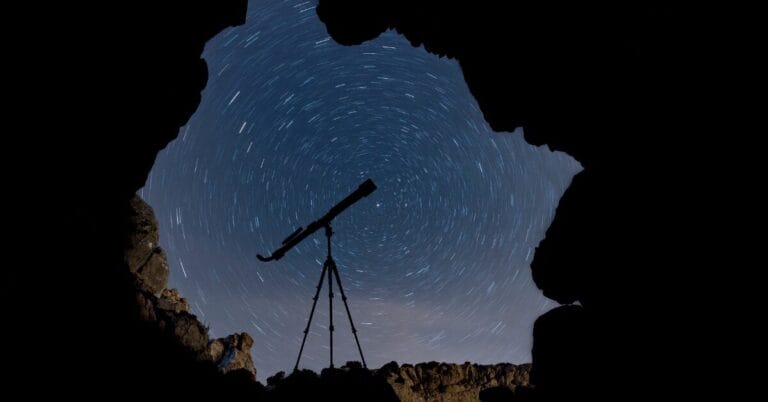The Best Telescopes Under $500 – A Top N List

Did you know you can see the Andromeda Galaxy with your eyes on a clear night? Imagine what you could see with a telescope. Space is full of amazing things. A telescope lets you see them close.
Looking at the stars and planets makes us curious. It makes us eager to learn more. With a telescope, you can explore the night sky. Discover incredible sights like craters on the moon, the rings of Saturn, and distant galaxies. It’s like having a front-row seat to the wonders of the universe.
This guide will help you find the best great telescopes under $500. We know choosing the right one can be confusing. We’ve made it simple. Whether you’re starting or upgrading, we have great options for you. Get ready to start your space adventure. See the stars like never before.
What to Consider When Choosing a Top Rated Telescope Under $500
Aperture: This is the size of the central part (mirror or lens) that collects light in a telescope. Bigger apertures collect more light, making images brighter and more transparent, especially for faint objects in deep space.
Mount: A stable mount is essential for smoothly following stars and planets as they move. Alt-azimuth mounts are easier to use, while equatorial mounts track more precisely but need some setup.
Ease of Use: For beginners, look for features like GoTo technology (computerized object location) or smartphone app integration to make stargazing easier.
Types of Telescopes:
- Refractor Telescopes: These telescopes use lenses to gather and focus light. They give clear images but can be more expensive if you want a bigger size. (Is the best refractor telescope under $500?)
- Reflector Telescopes: These telescopes use mirrors to collect light, making them cheaper for bigger sizes. They might need more maintenance to keep the mirrors aligned. (Best Celestron telescope under $500? Consider their reflector options!)
- Dobsonian telescope: It is a type of reflector telescope that is simple and easy to use. It has a big mirror to gather light and is mounted on a primary, sturdy base that moves up, down and side to side.
7 Top notch Telescope Recommendations (Under $500)
Celestron StarSense Explorer DX 130AZ:
This telescope is perfect for easy stargazing. With a big 5.1-inch aperture, it collects plenty of light, showing you amazing views of the moon’s craters and distant galaxies. The best feature is the particular StarSense smartphone app. This app uses your phone’s camera to find stars and planets in real-time. Point the telescope at the sky, open the app, and it will guide you. The telescope has a simple alt-azimuth mount, which is excellent for beginners. It lets you move the telescope smoothly without complicated setups. With its easy-to-use app, excellent light collection, and simple mount, the Celestron StarSense is a perfect choice for stargazers of all ages. Start your journey through the night sky with this incredible telescope.
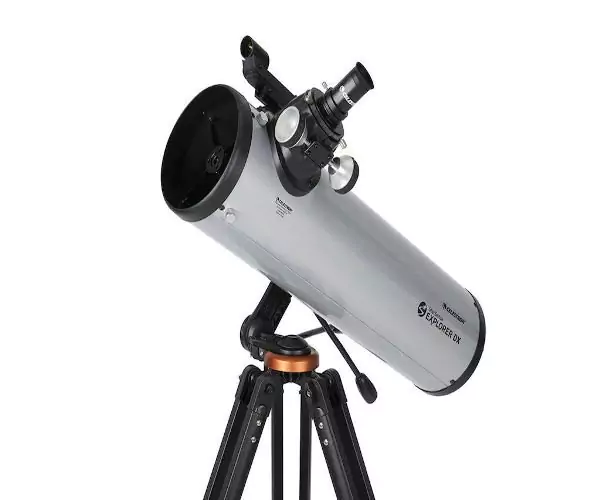
Celestron StarSense Explorer DX 130AZ
Beginner-friendly telescope with a smartphone app that guides you to objects in the night sky. Large 130mm reflector gathers plenty of light for stunning views of planets, moons, and deep space objects.
Pros
- Accurate star recognition
- Easy to assemble
- StarSense app is intuitive
- Large aperture for brightness
- Good for beginners
- Quality optics
- Red dot finder is helpful
- Fun and enjoyable
Cons
- Vibration when adjusting focus
- Manual Setup Required
- Bulky and Heavy
Specs:
| Feature | Specification |
| Brand | Celestron |
| Model Name | StarSense Explorer DX 130 |
| Optical Tube Length | 650 Millimetres |
| EyePiece Lens Description | Galilean |
| Objective Lens Diameter | 130 Millimetres |
| Telescope Mount Description | Altazimuth Mount |
| Product Dimensions | 38.98″ D x 16.93″ W x 8.98″ H |
| Focus Type | Manual Focus |
| Finderscope | Reflex |
| Item Weight | 18 Pounds |
Benefits
- Smartphone App-Enabled
- StarSense Technology
- Easy Setup
- High-Quality Optics
Celestron StarSense Explorer DX 102AZ
The StarSense Explorer DX 102AZ is like the little brother of the 130AZ. It gives you a similar experience but in a smaller size. A 4-inch aperture collects enough light to see many stars and planets. Like the 130AZ, it uses the StarSense app to turn your smartphone into a powerful tool for stargazing. The easy-to-use alt-azimuth mount makes moving the telescope simple. You can quickly point it at the sky and enjoy the view. The smaller aperture means you might not see some faint objects, as with the 130AZ. However, the 102AZ is still an excellent choice for beginners. It’s user-friendly, full of features, and reasonably priced.
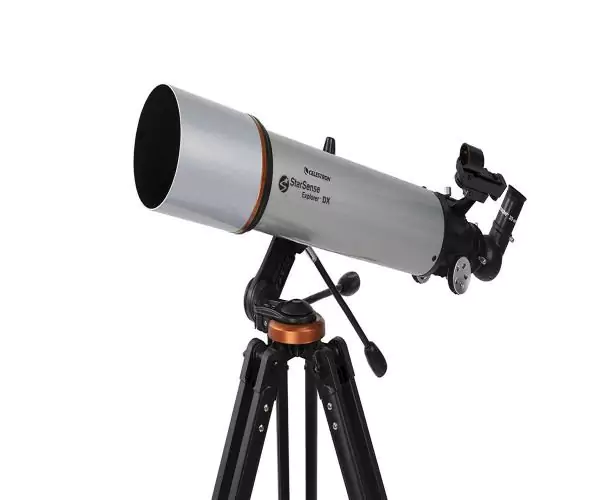
Celestron StarSense Explorer DX 102AZ
Similar to the 130AZ but with a slightly smaller 102mm reflector. Great for beginners with its user-friendly StarSense app and easy setup.
Pros
- Easy to Use
- Good Optics
- Portable
- All-Inclusive Package
Cons
- Limited Magnification
- Manual Mount
Specs
| Feature | Specification |
| Model Name | StarSense Explorer DX 102 |
| Eye Piece Lens Description | Galilean |
| Objective Lens Diameter | 102 Millimetres |
| Telescope Mount Description | Altazimuth Mount |
| Product Dimensions | 38.98″ D x 16.93″ W x 8.98″ H |
| Finderscope | Reflex |
| Item Weight | 6.4 Kilograms |
Benefits
- StarSense Technology
- Easy Setup
Orion StarMax 90 Tabletop Dobsonian
The Orion StarMax 90 Tabletop Dobsonian is all about simplicity. This telescope is perfect for people who want something easy to use. The Dobsonian mount is straightforward to set up. Just put the telescope on a flat surface, point it at the sky, and you are ready to explore. The design is easy to use, so you can quickly point and follow stars and planets. The 3.5-inch aperture is not the biggest, but it is excellent for seeing the moon, planets, and bright star clusters. You can also see some nearby nebulae. The Orion StarMax 90 is perfect for beginners. It is user-friendly and helps you get started with stargazing without any hassle. Enjoy the night sky with this easy-to-use telescope.
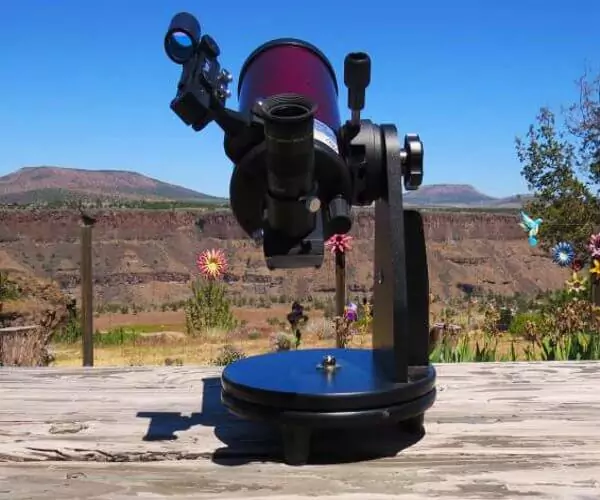
Orion StarMax 90 Tabletop Dobsonian
Compact and portable Dobsonian telescope. Ideal for beginners with its simple design and easy-to-use alt-azimuth mount. Good for observing planets, moon, and brighter deep sky objects.
Pros
- Portable
- Excellent optics
- Easy setup
- Good for moon & planets
- Lightweight
- Clear views
- Decent for beginners
Cons
- Defects in mirror
- Limited field of vision
- Jerky movement
Specs
| Feature | Specification |
| Optical Tube Length | 11.1 Inches |
| Eye Piece Lens Description | Bertele |
| Objective Lens Diameter | 90 Millimeters |
| Telescope Mount Description | Tabletop Alt-Az |
| Product Dimensions | 19.5″ D x 10.5″ W x 10.5″ H |
| Focus Type | Manual Focus |
| Finderscope | Reflex |
| Item Weight | 6.5 Pounds |
| Number of Batteries | 1 Lithium Metal battery required (included) |
Benefits
- Portable
- Compac
- tPowerful Views
- Stable Base
Celestron PowerSeeker 127EQ:
The Celestron PowerSeeker 127EQ is excellent for people who want to look closely at planets. It has a 5-inch aperture gathers enough light to see details on celestial objects like Saturn’s rings or Jupiter’s clouds. The telescope has different eyepieces that let you zoom in on specific features. The equatorial mount needs some setup knowledge at first. It helps track objects smoothly as they move across the sky, which is essential when using high magnifications. Even small movements can make objects drift out of view with high magnification. If you’re interested in seeing the detailed features of planets and their moons, the Celestron PowerSeeker 127EQ is a good choice in this price range. It allows you to explore our solar system’s wonders up close.
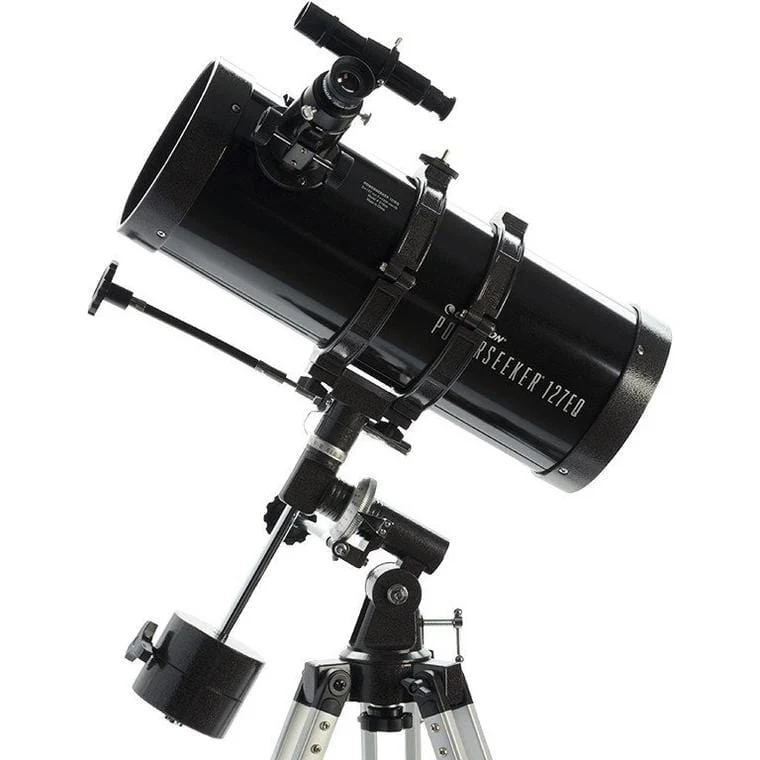
Celestron PowerSeeker 127EQ:
A 127mm reflector telescope on a manual equatorial mount. Offers decent views of planets, the moon, and brighter deep sky objects. Ideal for beginners looking for a more hands-on experience.
Pros
- Good value for money
- Clear and detailed views
- Stable mount
- Easy setup
- Useful accessories
- Great customer service
Cons
- Flimsy stand
- Need for upgrades
Specs
| Feature | Specification |
| Brand | Celestron |
| Model Name | Celestron PowerSeeker |
| Optical Tube Length | 400 Millimeters |
| Eye Piece Lens Description | Barlow |
| Objective Lens Diameter | 127 Millimeters |
| Telescope Mount Description | Equatorial Mount |
| Product Dimensions | 8.46″ D x 16.73″ W x 29.92″ H |
| Focus Type | Manual Focus |
| Item Weight | 21.4 Pounds |
Benefits
- Easy-to-use
- Powerful
- CompactPortable
- Multiple accessories
Celestron FirstScope 76
The Celestron FirstScope 76 is perfect for casual stargazing or astronomy on the move. It’s compact and easy to carry, making it great for camping, backyard observing, or even stargazing from your balcony. With its 3-inch aperture, you can see the moon pretty well and spot some craters and dark plains. While faint, deep-sky objects might not be apparent, the FirstScope 76 is a good choice for beginners who want a portable telescope to explore the brighter parts of the night sky.
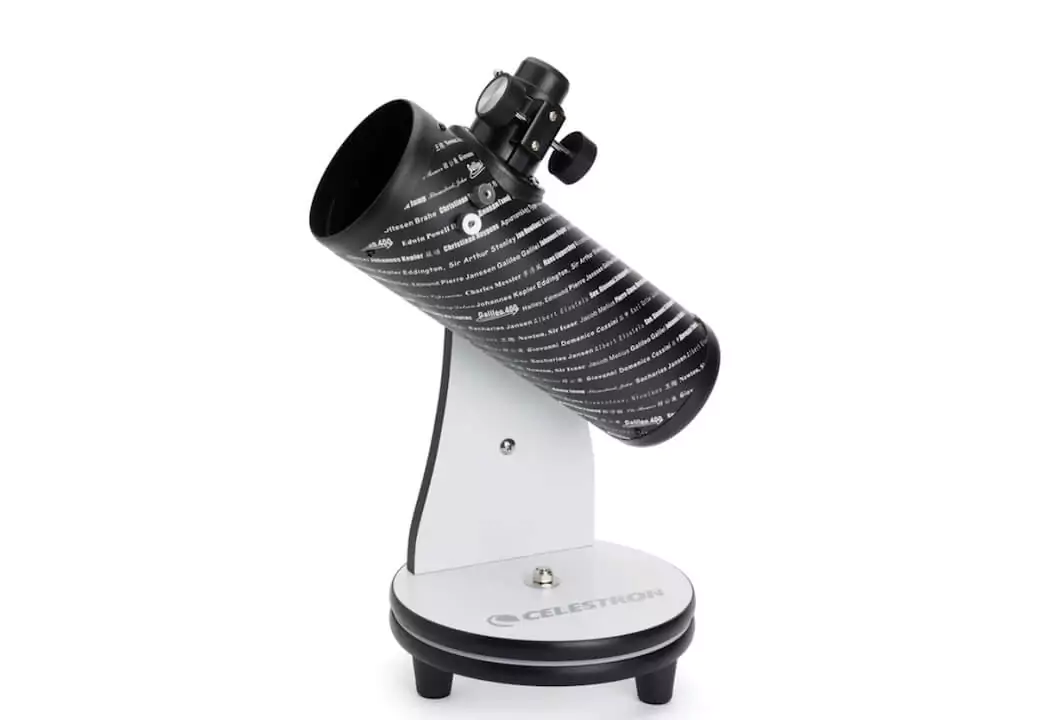
Celestron FirstScope 76
User-friendly refractor telescope with a 76mm aperture. Great for beginners interested in exploring the night sky. Easy to set up and use, with good views of the moon, planets, and star clusters.
Pros
- Portable
- Sturdy base
- Easy to use
- Great for kids
- Good value
- Adjustable tension knob
- Large field of view
- Solid performance
Cons
- No automatic tracking
- Limited magnification
- Limited zoom
Specs
| Feature | Specification |
| Brand | Celestron |
| Optical Tube Length | 70 Millimeters |
| Eye Piece Lens Description | Brandon |
| Objective Lens Diameter | 76 Millimeters |
| Telescope Mount Description | Altazimuth Mount |
| Focus Type | Manual Focus |
| Finderscope | Reflex |
| Item Weight | 3.7 Pounds |
| Lens Coating Description | Aluminum; Silicon Dioxide |
Benefits
- Portable
- Easy to use
- Tribute to astronomers
- Two eyepieces included
Orion StarBlast II 4.5 EQ
The Orion StarBlast II 4.5 EQ is perfect for astronomy lovers fascinated by deep space. It’s designed to give clear views of faint celestial objects like nebulae, galaxies, and distant star clusters. What makes it unique is its 4.5-inch parabolic mirror. Unlike spherical mirrors that can distort light, the parabolic design minimizes these distortions, giving you sharper and more detailed views. This is essential for seeing the intricate structures of deep-sky objects. Though it needs some setup, the equatorial mount helps track these celestial bodies smoothly as they move across the sky. This is crucial for observing faint objects in deep space because even slight movements can make them disappear from view. Suppose you’re eager to explore the far reaches of the universe and admire the beauty of nebulae, galaxies, and star clusters. In that case, the Orion StarBlast II 4.5 EQ is a powerful telescope perfect for you.
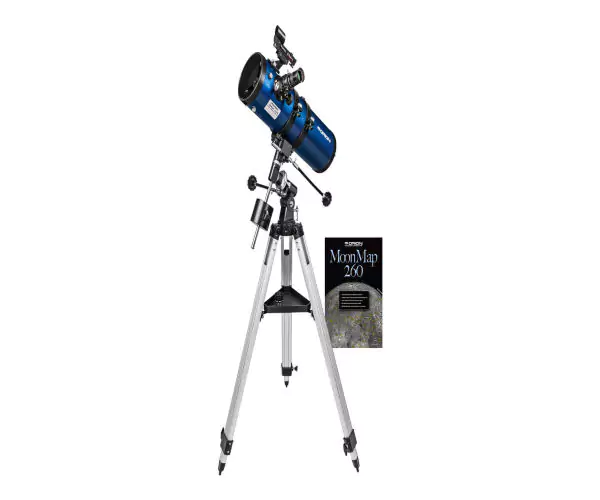
Orion StarBlast II 4.5 EQ
Compact and portable equatorial mount telescope with a 4.5-inch reflector lens. Good for observing the moon, planets, and brighter deep sky objects. Easy to use for beginners with its equatorial mount.
Pros
- Good quality for price
- Compact & portable
- Clear views of planets
- Easy to transport
- Compatible with additional eyepieces
- Includes cell phone bracket for photos
Cons
- Focusing knob issues
- Mount stability in wind
Specs
| Feature | Specification |
| Brand | Orion |
| Optical Tube Length | 18 Inches |
| Eye Piece Lens Description | Plossl |
| Objective Lens Diameter | 114 Millimeters |
| Telescope Mount Description | Equatorial Mount |
| Focus Type | Manual Focus |
| Finderscope | Reflex |
| Item Weight | 20.7 Pounds |
Benefits
- Portable
- Easy-to-use
- Wide-field optics
- Included accessories
Orion SpaceProbe II
The Orion SpaceProbe II is an excellent telescope for beginners in astronomy. It has a 70mm aperture, smaller than others, but it still gives fantastic views of the moon, bright planets, and even some closer deep-sky objects. It comes with an alt-azimuth mount that’s easy to use. You don’t need much setup; it lets you point and follow objects easily. The SpaceProbe II also includes different eyepieces for zooming in and a red-dot finder to help you aim at objects. With its easy-to-use design, reasonable price, and useful accessories, the Orion SpaceProbe II is a good choice for beginners excited to explore the skies.
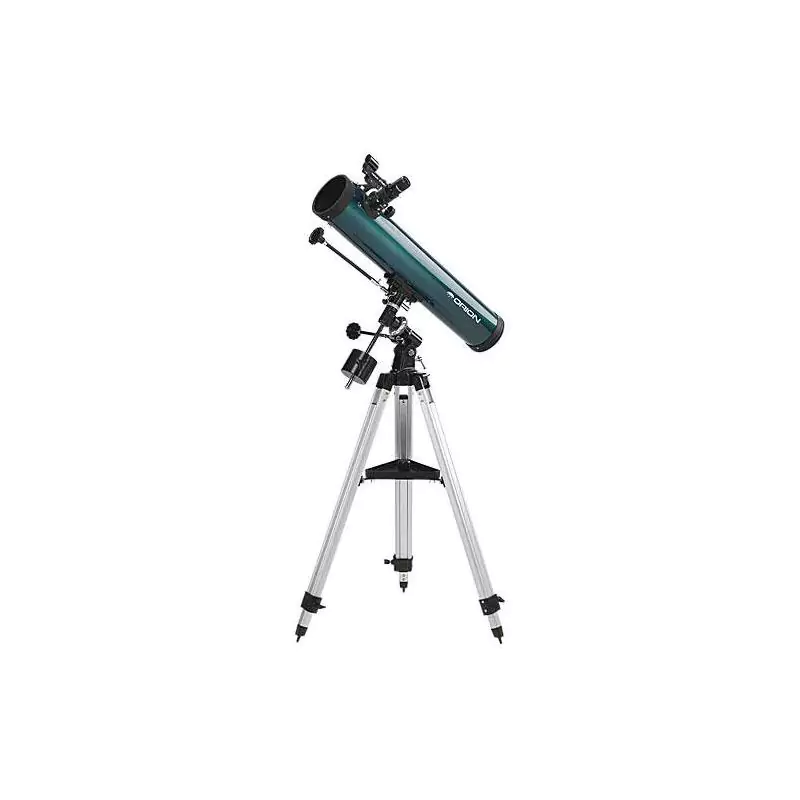
Orion SpaceProbe II
Beginner-friendly refractor telescope with a 70mm aperture. Ideal for introducing users to the wonders of astronomy. Easy to use and portable, with views of the moon, planets, and some brighter deep sky objects.
Pros
- Easy assembly
- Clear images
- Sturdy & durable
- Good price
Cons
- Red dot finder issues
- No solar filter
Specs
| Feature | Specification |
| Brand | Orion |
| Model Name | SpaceProbe |
| Optical Tube Length | 26.2 Inches |
| Eye Piece Lens Description | Kellner |
| Objective Lens Diameter | 76 Millimeters |
| Telescope Mount Description | Equatorial Mount |
| Focus Type | Manual Focus |
| Power Source | Battery Powered |
| Finderscope | Reflex |
Benefits
- Beginner-friendly
- Moon & Planets Viewing
- Sturdy Tripod
- Slow-motion Tracking
- Coated Eyepieces
More Tips for Choosing a Telescope
Accessories Matter: Remember to get essential accessories such as eyepieces for different magnifications, a star chart for finding celestial objects, and a red headlamp to keep your night vision sharp.
Join Astronomy Clubs: Joining local astronomy clubs is a smart move! They provide helpful advice and opportunities to observe with experienced members, and sometimes, you can even borrow equipment to try out.
Conclusion
In conclusion, choosing a telescope under $500 lets you explore space. Whether it’s a refractor, reflector, or Dobsonian, each has its advantages. Look at things like how clear you can see with the aperture size, how easy it is to use the mount, and what accessories help you see more. Consider buying used telescopes and joining local astronomy clubs for advice. The best telescope for you fits your goals and budget. Get ready to start your stargazing journey with a telescope that helps you discover new things.
FAQS
Which is the best telescope to see all planets?
A good choice would be a Dobsonian telescope with at least 6 inches of aperture, like the Orion SkyQuest XT6 or XT8. They offer great views of planets and deep-sky objects.
How much do perfect telescopes cost?
Prices vary widely, but a quality telescope for planetary viewing can range from $200 to $2000 or more, depending on size, optics, and features.
What is the best telescope around $1500?
For around $1500, consider the Celestron NexStar 8SE or the Meade LX90. These are Schmidt-Cassegrain telescopes with excellent optics and automated tracking.
What would be the best telescope to buy?
The “best” telescope depends on your needs. For planetary viewing, look for one with at least 6 inches of aperture, good optical quality, and ease of use. Popular options include Dobsonian telescopes and Schmidt-Cassegrains, which are within your budget.



